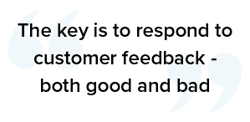The ultimate goal for your call center is to provide a positive customer experience. However, building brand loyalty and improving efficiency and productivity without quality assurance (QA) isn’t possible. You can’t boost revenue and ROI in your contact center without first evaluating how successful you are at helping customers.
For most contact centers, there’s an overwhelming amount of data associated with QA monitoring and measurement. And since time and resources are scarce, your team needs to focus on data collection and interpretation that matters most.That’s why it’s essential to take a step back and look at the big picture of your contact center QA. Your Net Promoter Score (NPS) is critical: operationally, tactically, and strategically.
NPS is a gold standard metric for measuring customer experience and assessing customer loyalty. It is a single query survey that customers take after contacting your contact center via phone, email, social media, or live chat. Customers answer the question, “On a scale of 0 – 10, how likely are you to recommend the company or agent you spoke with to a colleague or friend? Why?”
Based on customer responses to the scale question—with 0 representing extremely unlikely to recommend and 10 representing extremely likely to recommend—the company is given a quantitative score. That score is then divided into three buckets:
To calculate your company NPS, follow these three steps:
Here’s what that looks like when you’ve received 100 total survey responses:
Net Promoter Score (60% Promoters - 10% Detractors) = 50
In the contact center, any score over 50 is considered good; it means you have at least 50% more Promoters than you do Detractors. However, knowing your score is just the first step.
Potentially the most important element of NPS is the “Why?” question that many customers answer. The “why” will give you far more actionable insight into what you’re doing well and how you can improve. The “why” takes you from scores to behaviors, which is key for implementing effective changes that result in more Promoters.
 So why is NPS an essential call center metric? Beyond telling you what your customers think of you, it has a direct impact on how well your business performs.
So why is NPS an essential call center metric? Beyond telling you what your customers think of you, it has a direct impact on how well your business performs.
According to a 2003 article in the Harvard Business Review, a company’s NPS can predict growth, revenues, the life of the company, and the overall state of the customer-company relationship.
NPS should be the beating heart of a call center strategy. It represents the primary way customers survey their experience, so it’s critical to improving your customer loyalty and retention. When used correctly, NPS can tell you how well your agents are performing, on which channels you excel, how often you resolve issues, and if customers are satisfied with their experience.
Call centers that utilize NPS as part of their strategic QA framework recognize increased return-on-investment and stay ahead of the competition. The key is how well you can implement and improve NPS.
Below are seven steps to improve your call center NPS and thus the overall customer experience.
The key is to study your quantitative and qualitative NPS responses consistently. You can’t determine if adjustments are needed and what those adjustments are if you don’t know where you’re starting.
Create a regular NPS report that breaks down your Promoters, Passives, and Detractors (we’ll be talking about the value of each of these customer types in Step 3). The report should include responses from follow-up and open-ended questions, and it should display a chart of change over time. By doing this, you can determine the key drivers that directly influence your NPS score and make decisions and adjustments that benefit your team and customers.
You also need a streamlined internal quality assurance process and software, such as Scorebuddy, that can help you assess every interaction in real-time. You need to be able to drill down into patterns and trends across your call center—both individually and collectively—to monitor quality and create positive change.
Your call center managers should routinely listen to recorded interactions that scored well and those that missed the mark entirely. In this way, you can see which customer-centric actions were taken and which achieved positive results or fell flat.
From there, you can create an outcome-based QA compliance form. This checklist should help you evaluate if your customer service agents are achieving the customer experience outcomes you want based on careful evaluation of what works and what doesn’t.
Some of the questions you want to answer on your QA form include:
The goal should be to create an assessment that helps you determine if each call achieves the optimal outcome for that interaction. That agent feedback is invaluable for improving NPS.
 You need to engage with both Promoters and Detractors and even Passives.
You need to engage with both Promoters and Detractors and even Passives.
The key is to respond to customer feedback, both good and bad. Follow up with your Promoters to thank them for their loyalty and to demonstrate your continued commitment to helping them. And follow up with your Detractors and Passives to let them know that you are actively working to improve and solve their issues.
From there, you can identify poor performing agents through negative feedback, and act on that feedback and sentiment to make changes. One of the easiest ways to do this is to implement software that can help you collect performance data, analyze it, and put together the time and resources to train.
Ensure that your managers are committed to regular training, coaching, and advising. Make it more than just a once-in-a-while action, but a consistent part of working in the call center. Do everything you can to work on improving agent skills. It will have a long-term impact on the customer experience and your NPS.
Consistency is key when it comes to customer satisfaction (CSAT). Customers demand personalized service from call centers every time they contact you. And while it can be incredibly difficult to measure consistency, it’s essential.
To do this, first, define what it means to deliver consistent service. Then, set attainable benchmarks that are not only measurable but are also easily translatable and shareable. For example, you might measure such data points as client retention, staff churn, first contact resolution rate, response time, and most importantly CSAT and NPS.
By measuring each of these data points and reviewing your results on a regular basis, you can focus on consistently achieving the same scores and thus delivering comparable results.
Customers don’t want to call into your contact center and get the run-around. The last thing they want is to have to be sent to multiple departments to get the help they need. Transferring calls only decreases customer satisfaction and increases the chance of a negative customer experience.
Instead, remove the silos in your call center that require customers to move from one department to another for the answer they need. Empower your agents with the tools, resources, and knowledge they need to handle any call or questions that come their way. If you can ensure, with the right training, that any agent can handle any task, you’ll improve NPS.
As part of this, you should also identify and reassign NPS leaders in your department. If you spread out your top performing agents, you expand your knowledge base across areas, which will help you lift the entire call center’s NPS.
NPS as a call center metric is powerful, but alone, it can’t tell you all you need to know. Your Net Promoter Score should be used in conjunction with a strategic quality assurance (QA) framework to set your call center goals and to determine if and how you’re capable of moving the needle forward.
Call centers that adhere to strategic QA frameworks are designed to deliver on the business’ strategic objectives and goals. They are structured to analyze, interpret, and share data that results in action. And they take into account all critical influences—the business, the customer, the client, and the agent—and aim to seamlessly set the standards, measure and collaborate across these partnerships.
Working within the strategic call center QA framework focuses on the following processes:
By concentrating on how to improve your call center customer experience strategy, you shift the focus of your NPS to actionable behaviors that deliver measurable business results. You create a culture of listening, evolving, and mutual respect. In the simplest of terms, a strategic QA framework creates a happier call center, which results in happier customers.
Improving your NPS is not a quick process. It’s a true representation of the health of your call center, and so it needs time and attention to improve. You should only make minor and major adjustments after a thorough investigation of your call center and the customer experience.
By using a combination of comprehensive call center reporting and NPS, you’re able to take an in-depth look at your customer experience and then decide where and how to make changes that have the largest impact on customer satisfaction. The key is to dedicate yourself to equipping your agents, bringing in management, and making strategic QA essential to your existence.